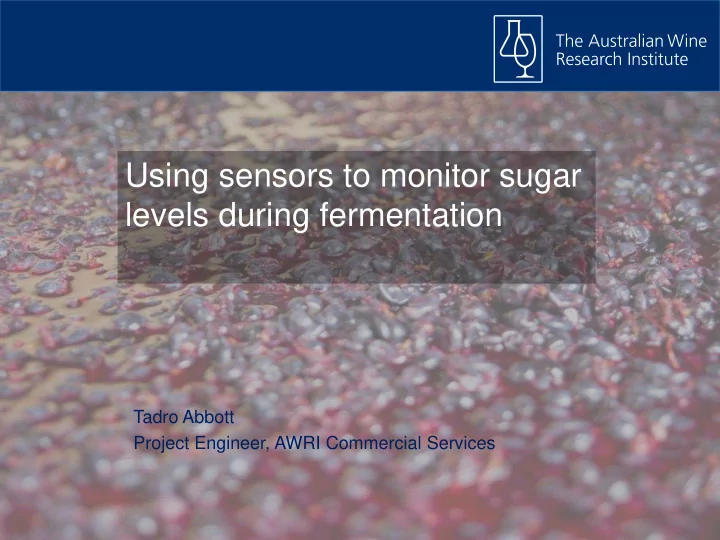

Using sensors to monitor sugar levels during fermentation Tadro Abbott Project Engineer, AWRI Commercial Services
The Fermentation Process
Fermentation process monitoring
Objectives
Evaluation criteria • Cost • Ease of installation • Connectivity • Setup/calibration • Sensitivity to process environment • Accuracy and repeatability
Screening technology options Indicative cost Sensor Supplier Measurement principle Difficulty (per unit) Liquiphant Vibrating Endress & Hauser Density $2-3K Moderate Fork Deltapoint S Endress & Hauser Hydrostatic pressure High $3K combined Micropilot Endress & Hauser Volume (level) High Fermetrol Psitec Osmotic potential $2K Moderate MicroLDS ISSYS Mass flow (liquid) $1K Low VS-3000 Vital Sensors Mid-IR absorbance $3K Moderate Proline t-mass Endress & Hauser Mass flow (gas) $3K Moderate Biosensor OptiEnz Enzyme response $1-2K Low
Process sensor 1 Measures density via changes in oscillation frequency Density converted into Baume reading Density Computer accommodates up to 4 sensor inputs Liquiphant vibrating fork Wine Juice
Process sensor 2 Measures osmotic potential in grape juice Expansive pressure in semi-permeable polymer converted into electrical signal Initial Baume required to convert signal into ‘inferred’ Baume reading Fermetrol probe
Process sensor 3 Micro-coriolis flowmeter Measures flowrate, temperature, density and viscosity Density readings converted into Baume Micro-LDS sensor Flow through sensor – connected to sample tap
Petaluma Trial 2015 Density Computer • 6.5 kL white fermenter Data • Vibrating fork & Fermetrol probe mounted through logger modified door panel • Micro-LDS fed from sample tap • Fork data converted in Density Computer & locally Vibrating fork logged Temp • Fermetrol data stored locally probe • Micro-LDS measurements taken every 2hrs via solenoid Fermetrol probe valve & filter Micro-LDS + tablet • Samples taken daily by lab for reference analysis
De Bortoli Trial 2015 • 200 kL red fermenter return Must • Sensors mounted in by-pass loop VS-300 Sensor Micro-LDS Management sensor Data Station management • 400 µm filter to reduce solids in flow stream station • Restrictor to reduce turbulent flow and bubbles Vibrating Temp fork probe • Local data management station to process VS-3000 sensor sensor outputs Fermetrol • Samples taken daily by lab for reference probe analysis Filter Mono pump
Vibrating fork data – white ferments
Vibrating fork data – white ferments
Vibrating fork data – white ferments
Vibrating fork – red ferments YALUMBA Density Probe Hydrometer Temperature Probe T (ºC) 16 35 14 30 12 Temperature ( ˚ C) 25 10 Baume 20 8 15 6 10 4 5 2 0 0 25/03 27/03 29/03 31/03 2/04 4/04 6/04 Data supplied by Yalumba Wines
Vibrating fork data – red ferments Image courtesy of Endress/Hauser & Yalumba Wines
Fermetrol data – white ferments
Fermetrol – red ferments ST HALLETT 30 25 20 Temperature/Baume 15 10 5 0 1 2 3 4 5 6 7 8 Days Data supplied by St. Hallett Wines/Psitec
Micro-LDS data – white ferments
Micro-LDS data – white ferments
Trial summary • Commercial sensors do provide a viable option BUT • Implementation is not simple • Fermentation is a harsh environment • Solids pose various problems Need to be willing to spend the time to get it right
Cost benefit analysis Approx. no. Total no. Tank size Winery size Crush (t) Av. kL processed tanks ferments/vintage (average kL) Small <500 10 30 7.5 225 Medium 500-2,500 25 75 15 1,125 Large 2,500-50,000 50 150 50 7,500 Huge >50,000 100 300 250 75,000 Operating Operational Total initial Payback period Winery size Crush (t) expenses ($ p.a.) savings ($ p.a.) investment ($) (years) initial year initial year Small <500 22,500 272 15,367 2.79 Medium 500-2,500 56,250 672 36,542 2.36 Large 2,500-50,000 112,500 1,338 118,084 1.66 Huge >50,000 225,000 2,665 461,168 0.76
Payback Period 4.0 3.5 Breakdown of savings 3.0 50% 2.5 40% 30% Pay-back (yrs) 2.0 20% 1.5 10% 1.0 0% 0.5 0.0 Small Medium Large Huge Winery size
The future?
Ferment Simulator 2017
Acknowledgements
Recommend
More recommend